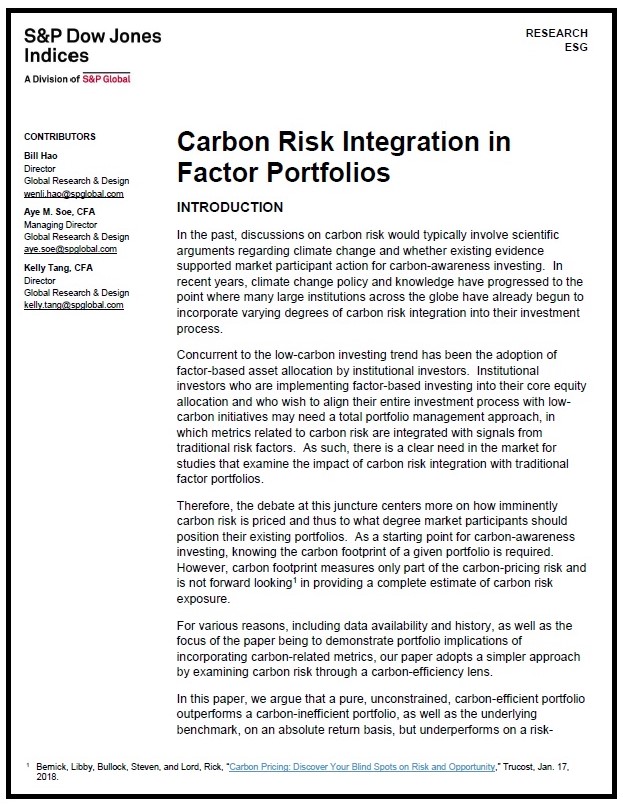Carbon Risk Integration in Factor Portfolios
In the past, discussions on carbon risk would typically involve scientific arguments regarding climate change and whether existing evidence supported market participant action for carbon-awareness investing. In recent years, climate change policy and knowledge have progressed to the point where many large institutions across the globe have already begun to incorporate varying degrees of carbon risk integration into their investment process.
Concurrent to the low-carbon investing trend has been the adoption of factor-based asset allocation by institutional investors. Institutional investors who are implementing factor-based investing into their core equity allocation and who wish to align their entire investment process with low-carbon initiatives may need a total portfolio management approach, in which metrics related to carbon risk are integrated with signals from traditional risk factors. As such, there is a clear need in the market for studies that examine the impact of carbon risk integration with traditional factor portfolios.
Therefore, the debate at this juncture centers more on how imminently carbon risk is priced and thus to what degree market participants should position their existing portfolios. As a starting point for carbon-awareness investing, knowing the carbon footprint of a given portfolio is required. However, carbon footprint measures only part of the carbon-pricing risk and is not forward looking1 in providing a complete estimate of carbon risk exposure.
For various reasons, including data availability and history, as well as the focus of the paper being to demonstrate portfolio implications of incorporating carbon-related metrics, our paper adopts a simpler approach by examining carbon risk through a carbon-efficiency lens.
In this paper, we argue that a pure, unconstrained, carbon-efficient portfolio outperforms a carbon-inefficient portfolio, as well as the underlying benchmark, on an absolute return basis, but underperforms on a risk-adjusted basis due to the portfolio having higher volatility. Moreover, we discuss how the carbon-efficient portfolio exhibits unintended sector and factor biases. Using the correlation of carbon intensity with style factors, we demonstrate a stylized framework in which carbon-efficient portfolios (both unconstrained and sector relative) can be combined with traditional risk factors to lower carbon intensity while maintaining the target factor exposure.
Through this analysis, we merge two powerful trends that are shaping the investment industry, and we provide a framework that can be used by institutional investors who wish to be sustainability-driven while focusing on achieving risk/return profiles that are specified in their investment mandates. We show that carbon-efficient factor portfolios can be a meaningful part of the core equity strategic and tactical asset allocation process.
The framework we have provided in our paper is by no means exhaustive. There are numerous ways to achieve decarbonized factor portfolios, each with its own tradeoffs and unique characteristics. Hence, in subsequent papers, we intend to explore additional case studies and provide stylized examples through which advantages and disadvantages of each approach can be further understood.
To download the full report, please click here.

